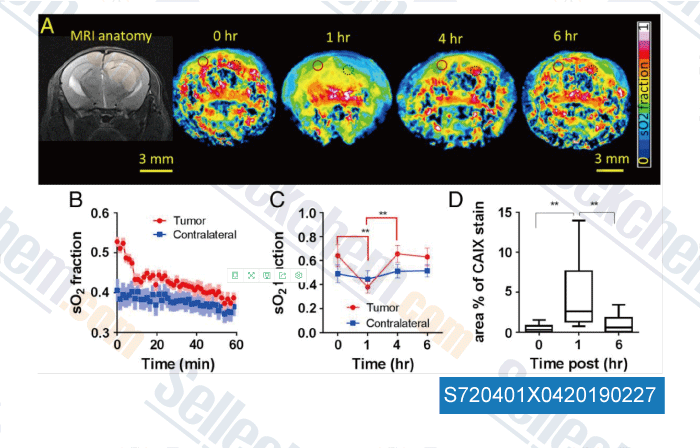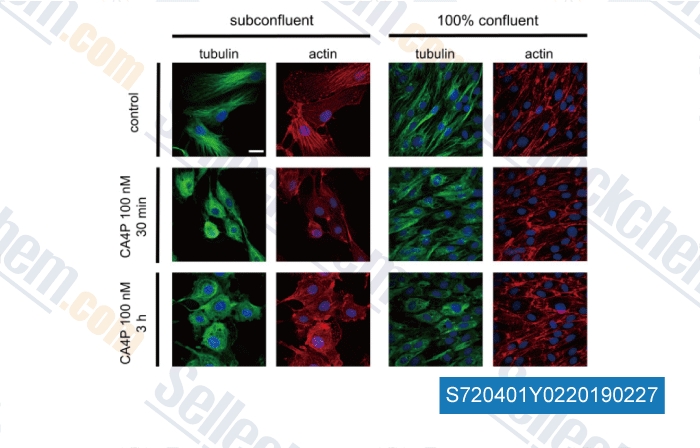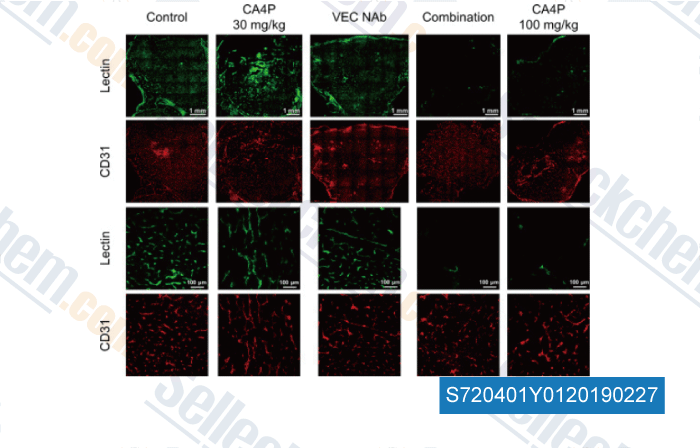|
Toll Free: (877) 796-6397 -- USA and Canada only -- |
Fax: +1-832-582-8590 Orders: +1-832-582-8158 |
Tech Support: +1-832-582-8158 Ext:3 Please provide your Order Number in the email. |
Technical Data
| Formula | C18H19O8P.2Na |
|||
| Molecular Weight | 440.29 | CAS No. | 168555-66-6 | |
| Solubility (25°C)* | In vitro | Water | 28 mg/mL (63.59 mM) | |
| DMSO | Insoluble | |||
| Ethanol | Insoluble | |||
|
* <1 mg/ml means slightly soluble or insoluble. * Please note that Selleck tests the solubility of all compounds in-house, and the actual solubility may differ slightly from published values. This is normal and is due to slight batch-to-batch variations. * Room temperature shipping (Stability testing shows this product can be shipped without any cooling measures.) |
||||
Preparing Stock Solutions
Biological Activity
| Description | Fosbretabulin (Combretastatin A4 Phosphate) Disodium is the water-soluble prodrug of Combretastatin A4 (CA4), which is a microtubule-targeting agent that binds β-tubulin with Kd of 0.4 μM in a cell-free assay. Fosbretabulin Disodium inhibits the polymerization of tubulin with IC50 of 2.4 μM, and also disrupts tumor vasculature. Fosbretabulin disodium induces mitotic arrest and apoptosis in endothelial cells. Phase 3. | ||
|---|---|---|---|
| Targets |
|
||
| In vitro | Fosbretabulin disodium (Combretastatin A-4 phosphate disodium, CA4P disodium) is the water-soluble prodrug of combretastatin A4 (CA4), which is originally isolated from African tree Combretum caffrum. CA4 is cytotoxic towards proliferating but not quiescent endothelial cells, has potent and selective toxicity towards tumor vasculature. [2] CA4P (1 mM, 30 minutes) disrupts the endothelial microtubule cytoskeleton and mediates changes in endothelial cell morphology. CA4P stimulates actin stress fiber formation and membrane blebbing and increases monolayer permeability via Rho/Rho-kinase. [3] CA4P increases endothelial cell permeability, while inhibiting endothelial cell migration and capillary tube formation predominantly through disruption of VE-cadherin/β-catenin/Akt signaling pathway, thereby leading to rapid vascular collapse and tumor necrosis. [4] |
||
| In vivo | CA4P causes rapid, extensive and irreversible vascular shutdown in experimental tumor models following the administration of a single dose at 10% of the maximum tolerated dose (MTD). CA4P causes a 93% reduction in vascular volume 6 h following drug administration. [2] CA4P(100 mg/kg, 6 h following administration) reduces tumor blood by approximately 100-fold, compared with approximately 7-fold in the spleen. [5] |
||
| Features | Best for advanced solid tumors, anaplastic thyroid cancer, & choroidal neovascularization. |
Protocol (from reference)
| Kinase Assay: |
|
|---|---|
| Cell Assay: |
|
| Animal Study: |
|
References
|
Customer Product Validation

-
Data from [ , , Transl Oncol, 2018, 11(5):1251-1258 ]

-
Data from [ , , Res Vet Sci, 2017, 112:222-228 ]

-
Data from [ , , Res Vet Sci, 2018, 122:1-6 ]
Selleck's Fosbretabulin (Combretastatin A4 Phosphate) Disodium Has Been Cited by 14 Publications
| PI3K/AKT signaling mediates stress-inducible amyloid formation through c-Myc [ Cell Rep, 2025, 44(5):115617] | PubMed: 40272983 |
| Antitumor effect of anti-vascular therapy with STING agonist depends on the tumor microenvironment context [ Front Oncol, 2023, 13:1249524] | PubMed: 37655095 |
| Antitumor effect of anti-vascular therapy with STING agonist depends on the tumor microenvironment context [ Front Oncol, 2023, 13:1249524] | PubMed: 37655095 |
| The Global Phosphorylation Landscape of SARS-CoV-2 Infection [ Cell, 2020, 182(3):685-712.e19] | PubMed: 32645325 |
| The Global Phosphorylation Landscape of SARS-CoV-2 Infection [ Cell, 2020, 182(3):685-712.e19] | PubMed: 32645325 |
| Salmonella enterica Typhimurium engineered for nontoxic systemic colonization of autochthonous tumors [ J Drug Target, 2020, 10.1080/1061186X.2020.1818759] | PubMed: 32886538 |
| Power Doppler ultrasound and contrast-enhanced ultrasound demonstrate non-invasive tumour vascular response to anti-vascular therapy in canine cancer patients [ Sci Rep, 2019, 9(1):9262] | PubMed: 31239493 |
| Noninvasive Anatomical and Functional Imaging of Orthotopic Glioblastoma Development and Therapy using Multispectral Optoacoustic Tomography [Balasundaram G, et al. Transl Oncol, 2018, 11(5):1251-1258] | PubMed: 30103155 |
| 7α,8α-Epoxynagilactones and their glucosides from the twigs of Podocarpus nagi: Isolation, structures, and cytotoxic activities [ Fitoterapia, 2018, 125:174-183] | PubMed: 29355751 |
| Vascular disrupting effect of combretastatin A-4 phosphate with inhibition of vascular endothelial cadherin in canine osteosarcoma-xenografted mice [Izumi Y, et al. Res Vet Sci, 2018, 122:1-6] | PubMed: 30439557 |
RETURN POLICY
Selleck Chemical’s Unconditional Return Policy ensures a smooth online shopping experience for our customers. If you are in any way unsatisfied with your purchase, you may return any item(s) within 7 days of receiving it. In the event of product quality issues, either protocol related or product related problems, you may return any item(s) within 365 days from the original purchase date. Please follow the instructions below when returning products.
SHIPPING AND STORAGE
Selleck products are transported at room temperature. If you receive the product at room temperature, please rest assured, the Selleck Quality Inspection Department has conducted experiments to verify that the normal temperature placement of one month will not affect the biological activity of powder products. After collecting, please store the product according to the requirements described in the datasheet. Most Selleck products are stable under the recommended conditions.
NOT FOR HUMAN, VETERINARY DIAGNOSTIC OR THERAPEUTIC USE.
